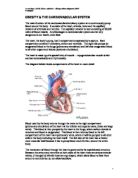Heart Disease
The heart is a powerful muscle that pumps blood all over the body. In order to be healthy, the heart muscle needs oxygen and this is supplied through the blood by the coronary arteries. Heart Disease occurs when the coronary arteries become narrowed by arteriosclerosis. This is where the lining of the arteries gradually become 'furred-up' with fatty deposits known as plaques. Over time, the artery may become so narrow that it is unable to deliver enough oxygen-containing blood to the heart when demands are high, for example during physical exertion, and this is known as angina. Furthermore, the fat in the arteries can attract blood cells that clot together blocking the artery off completely and starving the heart of oxygen causing permanent damage to the muscle. This is what happens during a heart attack. Obese people have a large intake of food and excess energy . This means all the extra energy is stored as fat and this fat enters the arteries which means less blood, which carries the oxygen around the body, can get through and the risk o0f heart disease increases.
High Blood Pressure
Blood is carried from the heart to all parts of your body in vessels called arteries. Blood pressure is the force in the arteries when the heart beats (systolic pressure) and when the heart is at rest (diastolic pressure). Everyone has a different blood pressure and it can change in the same person during the day and night. Blood pressure can be measured using a sphygmomanometer (a hand-pumped arm cuff) and stethoscope or by a digital machine and it is written down as one number over the other like a fraction, for example: 120/80. The top number is the systolic pressure (heart beat) and the bottom number is the diastolic pressure (heart rest), and both numbers are important. High blood pressure is known as hypertension in medical terms and refers to high pressure in the arteries. A blood pressure reading of 140/90 is the level used to diagnose high blood pressure. If your blood pressure is consistently raised at these levels and above, it will need to be treated. This may involve making changes to your lifestyle and taking medication. If it is not treated then you will be more likely to have a heart attack, stroke, eye damage, and heart or kidney failure in the future. Almost one in three adults in the US and UK have high blood pressure making it a major health concern. The reasons that obesity causes hypertension are multiple, but it appears that the excess adipose (fat) tissue secretes substances that are acted on by the kidneys, resulting in hypertension. Additionally, with obesity there are generally higher amounts of insulin produced (because of the excess adipose tissue) and this excess insulin also elevates blood pressure.
Arthritis
Arthritis is a disease that results in the breakdown of cartilage and other joint tissues. Cartilage is a firm, rubbery material that covers the end of each bone and acts as a cushion between the bones. When the cartilage wears away, the bones grind together and thicken. Sometimes bony growths (spurs) form. Arthritis can affect any joint, but most commonly occurs in the weight-bearing joints of the hips, knees, feet, and spine. Being obese causes increase wear and tear on the weight-bearing joints. Over time, the extra weight is likely to damage these joints, especially the knees, hips, and back. Additionally, substances produced by fat cells may actually result in increased wear and tear, not only in the weight-bearing joints, but in other joints as well. Obese people weigh a lot and all this extra weight is put onto the joints which means the joints are damaged resulting in arthritis.
Predominance of Medical Conditions by Body Mass Index (BMI) for Men
Predominance of Medical Conditions by Body Mass Index for Women
Energy Drinks
Energy drinks are beverages that are designed to give the consumer a burst of energy by using a combination of methylxanthines, B vitamins, and exotic herbal ingredients. Energy drinks commonly include caffeine and other ingredients which boost energy and awareness. Some contain high levels of sugar, or glucose while most brands also offer an artificially sweetened version. Often manufacturers add a very small dose of a powerful stimulant such as carnitine, but the doses of these add-ins are usually so small that any added “boost” is purely psychological. These drinks are aimed at teenagers and active people like those who play sports. Energy drinks are beverages like Red Bull and Lucozade, which contain large doses of caffeine and other legal stimulants like ephedrine, guarana, and ginseng. Energy drinks may contain as much as 80 mg of caffeine, the equivalent of a cup of coffee. Compared to the 37 mg. of caffeine in a sprite, or the 23 mg. in a Coca-Cola can. Energy drinks' stimulating properties can boost the heart rate and blood pressure, dehydrate the body, and, like other stimulants, prevents sleep. Rising consumption of energy drinks that contain high levels of sugar and caffeine may be contributing to the rise in obesity. An energy drink containing sugar, added caffeine and guarana causes the body to convert sugar into fat more rapidly than lemonade. When the caffeine combines with the sugar in energy drinks it is converted into fat a lot quicker.








